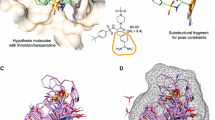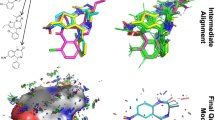Abstract
Computational methods for predicting ligand affinity where no protein structure is known generally take the form of regression analysis based on molecular features that have only a tangential relationship to a protein/ligand binding event. Such methods have utility in retrospective rationalization of activity patterns of substituents on a common scaffold, but are limited when either multiple scaffolds are present or when ligand alignment varies significantly based on structural changes. In addition, such methods generally assume independence and additivity of effect from scaffold substituents. Collectively, these non-physical modeling assumptions sharply limit the utility of widely used QSAR approaches for prospective prediction of ligand activity. The recently introduced Surflex-QMOD approach, by virtue of constructing physical models of binding sites, comes closer to a modeling approach that is congruent with protein ligand binding events. A set of congeneric CDK2 inhibitors showed that induced binding pockets can be quite congruent with the enzyme’s active site but that model predictivity within a chemical series does not necessarily depend on congruence. Muscarinic antagonists were used to show that the QMOD approach is capable of making accurate predictions in cases where highly non-additive structure activity effects exist. The QMOD method offers a means to go beyond non-causative correlations in QSAR analysis.












Similar content being viewed by others
References
Langham JJ, Cleves AE, Spitzer R, Kirshner D, Jain AN (2009) J Med Chem 52:6107
Alzate-Morales JH, Caballero J, Vergara Jague A, Gonzalez Nilo FD (2009) J Chem Inf Model 49:886
Jain AN, Dietterich TG, Lathrop RH, Chapman D, Critchlow RE, Bauer BE, Webster TA, Lozano-Perez T (1994) J Comput Aided Mol Des 8:635
Jain AN, Koile K, Chapman D (1994) J Med Chem 37:2315
Jain AN, Harris NL, Park JY (1995) J Med Chem 38:1295
Dietterich TG, Lathrop RH, Lozano-Perez T (1997) Artif Intell 89:31
Jain AN (1996) J Comput Aided Mol Des 10:427
Pham TA, Jain AN (2006) J Med Chem 49:5856
Pham TA, Jain AN (2008) J Comput Aided Mol Des 22:269
Johnson SR (2008) J Chem Inf Model 48:25
Cramer RD (2003) J Med Chem 46:374
Cramer RD, Patterson DE, Bunce JD (1988) J Am Chem Soc 110:5959
Cramer RD, Wendt B (2007) J Comput Aided Mol Des 21:23
Klebe G, Abraham U, Mietzner T (1994) J Med Chem 37:4130
Guner O, Clement O, Kurogi Y (2004) Curr Med Chem 11:2991
Snyder JP, Rao SN (1989) Chem Design Automation News 4:13
Vedani A, Zbinden P, Snyder JP (1993) J Recept Res 13:163
Zbinden P, Dobler M, Folkers G, Vedani A (1998) QSAR 17:122
Tanrikulu Y, Schneider G (2008) Nat Rev Drug Discov 7:667
Nordvall G, Sundquist S, Johansson G, Glas G, Nilvebrant L, Hacksell U (1996) J Med Chem 39:3269
Johansson G, Sundquist S, Nordvall G, Nilsson BM, Brisander M, Nilvebrant L, Hacksell U (1997) J Med Chem 40:3804
Benson ML, Smith RD, Khazanov NA, Dimcheff B, Beaver J, Dresslar P, Nerothin J, Carlson HA (2008) Nucleic Acids Res 36:D674
Nilvebrant L, Gillberg PG, Sparf B (1997) Pharmacol Toxicol 81:169
Acknowledgments
The authors gratefully acknowledge NIH for partial funding of the work (Grant GM070481), Brian Goldman and Jonathan Weiss for pointing out the CDK2 data set and providing corresponding data, and Ann Cleves for comments on the manuscript. Dr. Jain has a financial interest in BioPharmics LLC, a biotechnology company whose main focus is in the development of methods for computational modeling in drug discovery. Tripos Inc. has exclusive commercial distribution rights for Surflex-Sim and Surflex-Dock, licensed from BioPharmics LLC.
Author information
Authors and Affiliations
Corresponding author
Rights and permissions
About this article
Cite this article
Jain, A.N. QMOD: physically meaningful QSAR. J Comput Aided Mol Des 24, 865–878 (2010). https://doi.org/10.1007/s10822-010-9379-8
Received:
Accepted:
Published:
Issue Date:
DOI: https://doi.org/10.1007/s10822-010-9379-8




